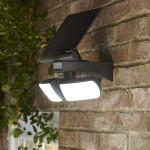```html
Best Solar Batteries for Outdoor Lights: A Comprehensive Guide
Solar-powered outdoor lights offer an environmentally friendly and cost-effective way to illuminate gardens, pathways, and patios. Their functionality hinges on the solar battery, which stores energy collected from sunlight during the day and releases it to power the lights at night. Selecting the optimal battery type is crucial for maximizing the lifespan and performance of solar outdoor lighting systems.
The performance of solar batteries for outdoor lights is influenced by several factors, including battery chemistry, capacity, charging and discharging cycles, operating temperature range, and overall durability. Different battery chemistries exhibit diverse characteristics that make them suitable for specific applications. Understanding these nuances is essential for informed decision-making when choosing batteries for solar outdoor lighting. The capacity of a battery, measured in milliampere-hours (mAh) or ampere-hours (Ah), dictates how long the lights can remain illuminated before requiring a recharge. The number of charge and discharge cycles a battery can withstand before its performance degrades significantly impacts its longevity and overall cost-effectiveness. Operational temperature range is a critical consideration, especially in regions with extreme weather conditions, as temperature fluctuations can affect battery efficiency and lifespan. Finally, the physical durability and resistance to environmental factors such as moisture and dust are essential for ensuring long-term reliability in outdoor settings.
This article explores the primary types of solar batteries commonly used in outdoor lighting applications, weighing their advantages and disadvantages to assist users in selecting the most appropriate option for their needs. Furthermore, it will delve into factors influencing battery performance and longevity, offering practical advice on optimizing battery life and maintaining solar-powered outdoor lighting systems.
Understanding Battery Chemistries for Solar Outdoor Lights
The choice of battery chemistry is paramount when selecting solar batteries for outdoor lights. Several options are available, each with distinct performance characteristics, lifespan, and cost considerations. The most prevalent types include Nickel-Cadmium (NiCd), Nickel-Metal Hydride (NiMH), and Lithium-Ion (Li-ion) batteries. Each of these chemistries presents a different balance of performance, cost, and environmental impact.
Nickel-Cadmium (NiCd) Batteries: NiCd batteries have been a long-standing option for solar outdoor lights due to their robustness and ability to withstand harsh environmental conditions. They exhibit a high tolerance for overcharging and deep discharging, making them relatively forgiving in demanding applications. However, NiCd batteries suffer from the "memory effect," where repeated partial discharges can lead to a reduction in their capacity over time. This effect can be mitigated through periodic full discharge cycles, but it remains a significant drawback. Furthermore, NiCd batteries contain cadmium, a toxic heavy metal, which poses environmental concerns related to disposal and recycling. Due to these environmental considerations and the presence of the memory effect, NiCd batteries are gradually being replaced by more environmentally friendly and technologically advanced alternatives.
Nickel-Metal Hydride (NiMH) Batteries: NiMH batteries offer a significant improvement over NiCd batteries in terms of environmental impact and energy density. They do not contain toxic heavy metals, making them a more eco-friendly choice. NiMH batteries also boast a higher energy density than NiCd batteries, meaning they can store more energy for a given size and weight. This translates to longer run times for solar outdoor lights. While NiMH batteries are less susceptible to the memory effect than NiCd batteries, they can still experience a gradual capacity reduction with repeated partial discharge cycles. Their self-discharge rate is also generally higher than that of NiCd batteries, meaning they lose charge more quickly when not in use. This characteristic can affect the overall performance of solar lights, particularly during periods of prolonged cloud cover. Despite these limitations, NiMH batteries offer a good balance of performance, cost, and environmental friendliness, making them a popular choice for many solar outdoor lighting applications.
Lithium-Ion (Li-ion) Batteries: Li-ion batteries represent the cutting edge of battery technology and are increasingly becoming the preferred choice for solar outdoor lights due to their superior performance characteristics. They offer the highest energy density of the three types, allowing for even longer run times and more compact designs. Li-ion batteries also exhibit a very low self-discharge rate, ensuring that the lights remain ready to use even after extended periods of inactivity. Crucially, Li-ion batteries do not suffer from the memory effect, maintaining their capacity even with repeated partial discharge cycles. However, Li-ion batteries are generally more expensive than NiCd and NiMH batteries. They also require sophisticated charging circuitry to prevent overcharging and overheating, which can lead to safety hazards. Despite these complexities, the superior performance and long lifespan of Li-ion batteries often outweigh the higher upfront cost, making them a cost-effective solution in the long run. Different types of Li-ion batteries exist, such as Lithium Iron Phosphate (LiFePO4), which offer enhanced safety and longer lifespan compared to standard Li-ion batteries.
Key Factors Influencing Battery Performance and Longevity
Beyond the battery chemistry, several factors significantly influence the performance and longevity of solar batteries in outdoor lighting applications. These factors include charging and discharging cycles, operating temperature range, depth of discharge, and maintenance practices.
Charging and Discharging Cycles: The number of charge and discharge cycles a battery can withstand before its performance degrades significantly is a critical metric for evaluating its lifespan. Each battery chemistry has a different cycle life. Generally, Li-ion batteries offer the longest cycle life, followed by NiMH and then NiCd batteries. Deep discharging, where the battery is completely drained before being recharged, can significantly reduce the cycle life of all battery types. Avoiding deep discharges and opting for shallower discharge cycles can help to extend the battery's lifespan. The quality of the solar panel and charging circuitry also plays a vital role in ensuring proper charging and preventing overcharging, which can damage the battery and shorten its lifespan. Regular and consistent charging cycles are essential for maintaining the battery's health and overall performance.
Operating Temperature Range: Temperature extremes can significantly affect battery performance and lifespan. High temperatures can accelerate the degradation of battery materials, leading to reduced capacity and a shorter lifespan. Low temperatures can decrease battery capacity and impede the charging process. Manufacturers typically specify an operating temperature range for their batteries. Selecting batteries that are well-suited to the local climate is crucial for ensuring optimal performance and preventing premature failure. In regions with hot summers, consider using batteries with high-temperature stability and placing the solar lights in shaded areas to minimize direct sunlight exposure. In cold climates, ensure that the batteries are protected from freezing temperatures, as this can cause irreversible damage. Furthermore, some advanced battery chemistries are specifically designed to perform better in extreme temperatures.
Depth of Discharge (DoD): The depth of discharge refers to the percentage of the battery's capacity that is discharged during each cycle. For example, discharging a battery to 50% of its capacity corresponds to a DoD of 50%. As mentioned earlier, deep discharges can significantly reduce the cycle life of batteries. Limiting the DoD to a lower percentage can help to extend the battery's lifespan. For instance, discharging a Li-ion battery to 20% DoD may result in a significantly longer cycle life compared to discharging it to 80% DoD. Some solar lights incorporate circuitry that prevents deep discharging to protect the battery and prolong its lifespan. Understanding the DoD limitations of different battery types and adjusting usage patterns accordingly can lead to significant improvements in battery longevity.
Optimizing Battery Life and Maintenance Tips
Proper maintenance and usage practices can significantly extend the lifespan of solar batteries in outdoor lights. Regular cleaning of the solar panel, replacing batteries when their performance degrades, and selecting appropriate locations for the lights are all important aspects of maintaining the system's efficiency and longevity.
Regular Cleaning of Solar Panels: Dust, dirt, and debris can accumulate on the surface of solar panels, reducing their efficiency in collecting sunlight. Regularly cleaning the panels with a soft cloth and mild detergent can help to maximize their energy output and ensure that the batteries are properly charged. The frequency of cleaning will depend on the local environment and the amount of dust and pollution. In areas with high levels of dust or pollen, more frequent cleaning may be necessary. Avoid using abrasive cleaners or harsh chemicals, as these can damage the surface of the solar panels. A simple wipe down with a damp cloth is usually sufficient to remove most debris.
Battery Replacement: Even with proper maintenance, solar batteries will eventually degrade over time and need to be replaced. The lifespan of a battery depends on its chemistry, usage patterns, and environmental conditions. When the lights start to dim or the run time becomes significantly shorter, it is a sign that the batteries are nearing the end of their lifespan. Replacing the batteries with the same type and capacity as the original batteries is crucial for ensuring proper performance and compatibility. Consider upgrading to a higher-quality battery chemistry, such as Li-ion, for improved performance and longevity, but ensure that the charging circuitry is compatible with the new battery type.
Optimal Light Placement: The placement of solar outdoor lights can significantly affect their performance. Ensure that the solar panels are positioned in a location that receives direct sunlight for several hours each day. Avoid placing the lights in shaded areas or under trees, as this will reduce the amount of sunlight that the panels receive and hinder the charging process. Orient the solar panels towards the south in the northern hemisphere and towards the north in the southern hemisphere to maximize sun exposure. Consider adjusting the angle of the solar panels seasonally to optimize sunlight capture throughout the year. Furthermore, protect the lights from extreme weather conditions, such as heavy rain or snow, to prevent water damage and corrosion.
```
The 8 Best Batteries For Solar Lights Reviews Guide Electronicshub

The 8 Best Batteries For Solar Lights Reviews Guide Electronicshub

Top Tips For Your Garden Solar Light Batteries Buy A Battery

The 8 Best Rechargeable Batteries For Solar Lights In 2024 Including Lithium And Nickel Cadmium Options

The 8 Best Batteries For Solar Lights Reviews Guide Electronicshub

The 8 Best Rechargeable Batteries For Solar Lights In 2024 Including Lithium And Nickel Cadmium Options

The 8 Best Batteries For Solar Lights Reviews Guide Electronicshub

What Types Of Battery Is The Best For Solar Street Lights Grnled

The 8 Best Rechargeable Batteries For Solar Lights In 2024 Including Lithium And Nickel Cadmium Options

The 7 Best Batteries For Solar Lights Energy Ers







